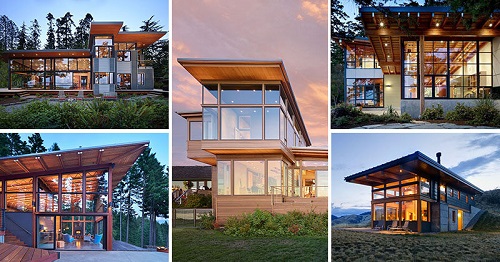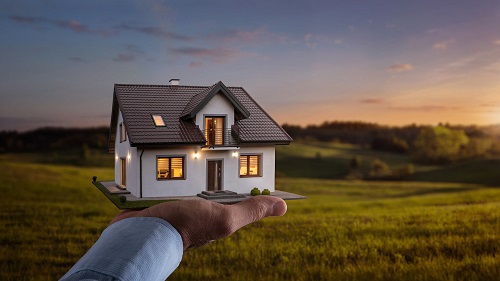
Mortgage Dove
20 Different Types of House Styles
Whether you're shopping for your first home or an investment property, you've probably noticed many terms around house styles and their structures. As you learn about the advantages of different home types, you will be able to select the home you want, anticipate common problems during your home inspection, and select the home you want with greater ease.
It's important to note that a home is classified by two main factors: the type of structure and the style. A structure is a type of building, such as a single-family house or a condominium. The style refers to the home's architectural features and design, such as Craftsman or contemporary. To help you narrow down your preferences and better find the perfect house, we have gathered the most famous structures and styles of homes.
Types Of Houses According To Structures
If you're looking to buy your first home, buy a rental property, or compare homes in your area as part of a home sale, the first thing you should do to narrow your search is to determine what kind of home structure you want. Listed below are the most common types you'll see when looking for a new place.
Apartment
Typically, apartments are found within one building structure that contains similar units. It is important to note that you must rent the place from a landlord. A laundry room, gym, pool, and on-site repair workers are all common features of apartments and apartment buildings.
While renting provides less privacy and does not build equity, there are many other pros and cons to consider when deciding whether to buy or rent.
Pros: Repairs and maintenance are well taken care of.
Cons: There is no option to purchase, which limits flexibility and freedom.
Condo
You might find a condo to be the perfect fit if you enjoy the conveniences of an apartment but would like to own your own home. Rather than having a building manager or landlord oversee your unit, you are responsible for all repairs and maintenance.
A condominium is a great option for city living and for older adults who want to own and have a mortgage but don't want to maintain a single-family residence.
Pros: A condo requires less maintenance than a single-family home, along with homeownership benefits.
Cons: Privacy and free agency are limited.
Co-Op
Co-ops are also known as housing cooperatives. Compared to the other types of housing on this list, co-ops are unique. In a co-op, you are not purchasing the building itself but buying a share of the company that owns it.
Typically, how much space you get in the co-op depends on how many shares you own. Co-ops allow you to vote on common spaces and split maintenance costs once you join and purchase shares.
Pros: Co-ops offer great community benefits and are more affordable than traditional homes.
Cons: You have less freedom and should seek approval from the group before making decisions.
Single-Family (Detached)
In contrast to condos, apartments, and townhomes, a single-family home is completely detached from other housing units. Single-family homes make up the majority of households in the U.S.
They are less common in highly populated areas and more common in suburbs. A single-family home offers more privacy and customization options (barring any homeowners association requirements).
Pros: Single-family homes offer greater privacy and freedom than most other housing types.
Cons: Their maintenance and ownership costs are typically higher.
Tiny Home
The popularity of tiny homes has boomed recently, spawning what is known as the “tiny home movement.” Tiny homes usually range from 60 to 400 square feet in size. Some prefabricated tiny homes are completely custom-built.
Many tiny houses are mobile and can be moved to new locations, making them popular among singles and couples who want more financial and physical freedom.
Pros: Tiny homes offer greater physical freedom and affordability.
Cons: There is significantly less space and less room for growing families.
Townhome
Generally speaking, a townhouse or townhome is an individually owned dwelling with at least one wall shared with another unit and its entrance from the street. There are many of them in big cities where there is a limited amount of space.
Townhomes utilize vertical space with multiple stories, but save horizontal space by sitting next to each other. There may be shared amenities between townhouses.
Pros: They're generally more affordable than single-family homes.
Cons: You have less privacy and less freedom to customize the exterior.
Types Of Houses According To Architectural Home Styles
Your home's architectural style will heavily influence the type of interior design you choose. People put a lot of effort into restoring these styles of houses, and some new builds attempt to recreate them.
Additionally, knowing the home's time will help you avoid typical problems associated with certain styles. When you conduct your final walkthrough, ask the seller about these common concerns.
Look at the different house styles below to determine which one best suits your lifestyle and preferences.
Cape Cod
Cape Cod architecture dates back to the 1700s in its namesake city in Massachusetts. Houses like these are charming, yet tough to stand up to the harsh New England winters.
Originally, Cape Cod homes had wood siding, roof shingles, and a central door with two windows on either side. Today, these elements are still incorporated, but the homes are bigger and have more windows.
Key features: Wood siding, shingles, central door with flanking windows
Colonial
There are many similarities between Colonial homes and Cape Cod homes. Their simple, rectangular, symmetrical structure dates back to the 1600s.
There are several types of colonial architecture, each influenced by the country that occupied the region at the time. English, French, Dutch, Georgian, Spanish, and American colonial types (which closely resemble English) are among these types.
Most Colonial homes are at least two stories high with a grand entryway and central staircase.
Key features: Formal look, two-plus stories tall, symmetrical, central stairway
Contemporary
Contemporary and modern styles are often confused but should not be used interchangeably. Modern means something from the past, and contemporary means something currently happening (e.g., midcentury modern).
In today's contemporary homes, modernist elements are often incorporated. With an emphasis on natural textures and clean lines, many use eco-friendly materials and designs. Color palettes are typically neutral with pops of color added to the interior.
Key features: Neutral colors, clean and simple lines, natural textures
Craftsman
In the Craftsman style, well-constructed, handmade architecture is emphasized. In contrast to mass-produced or cookie-cutter houses, Craftsman homes are typically horizontal, sturdy, and built to last.
In addition to their beautifully crafted materials and exposed beams, they have low-pitched gable roofs and tapered columns on their porches. Custom elements like built-in bookcases and a hand-laid fireplace can be found inside.
Key features: Large columns, hand-crafted wood features, exposed beams
Greek Revival
A Greek revival-style home is easily identifiable due to its impressive columns emulating those found on the Parthenon and other well-known Greek buildings. This style emerged in the U.S. during the 1830s, inspired by Greek democracy, philosophy, and culture. Greek-style columns, white or subdued colors, and grand entrances characterize these houses.
Key features: Grand entrance, large white columns, Greek-style embellishments
Farmhouse
Essentially, farmhouse-style homes take inspiration from their namesake buildings on both the inside and outside. These houses have tall ceilings, exposed beams, a large front porch, a rectangular layout, and a central fireplace.
Farmhouse-style homes can have barn-shaped roofs, or they can be less obvious. Bricks and stone are often exposed in the details, and the style is typically rustic. In modern farmhouse style, this rustic look is combined with more clean lines and other updated features.
Key features: Large porch, rustic, rectangular floor plan, barn-inspired roofs and features
French Country
A French country-style home is influenced by the abodes found in the French countryside, such as in the Provence region. There are a few similarities between them and farmhouse-style houses, but they are different styles. A typical French country home has a pointed roof and shutters and is typically constructed of stone. The interior features a stone fireplace, distressed wood, and subdued palettes with pastels and worn colors.
Key features: Stone exterior, provencal influences, weathered look
Mediterranean
A Mediterranean-style home incorporates elements from Spanish and Italian villas. Their popularity is largely due to their emphasis on indoor-outdoor living in temperate climates, such as California and Florida.
The homes have tiled roofs, white stucco walls, stone and wood interiors, with metal work on balconies and windows. Most Mediterranean-style houses have an understated look, but gorgeous tile work often adds a splash of color.
Key features: Tiled roofs, white stucco, warm wood and stone
Midcentury Modern
After WWII, the Bauhaus movement gave rise to midcentury modern design. The midcentury modern home is characterized by a sleek, uncluttered design, and large windows, with a mixture of natural and man-made materials. Designed with function and form in mind, these homes feature thoughtful architectural details.
Key features: Sleek, a mix of organic and geometric, uncluttered, large windows
Ranch
Ranch-style houses were first introduced in the 1930s but gained popularity in the 1950s. Low-pitched roofs, large windows, sliding glass doors, spacious backyards, open living areas, and attached garages are typical features of these homes.
There are also a variety of ranch-style houses available, including split-level homes, storybook homes, California ranches, and raised ranches. A California ranch home, for instance, is shaped in an "L" or "U," with a backyard to facilitate outdoor living.
Key features: Backyard, single story, low-pitched roof, open living spaces, and floor plans
Split-Level
A split-level home evolved from a ranch-style home in the 1950s and 1960s. The main difference between a split-level home and other homes is that the living spaces are separated. In split-level homes, there are multiple floors connected by short flights of stairs (unlike traditional two- or three-story homes with long flights of stairs). Although some find the numerous short flights of stairs cumbersome, others enjoy the unique separation of space.
Key features: Living spaces separated by short flights of stairs
Tudor
European-trained architects introduced the Tudor style to the U.S. in the late 1800s, and it gained popularity in the 1920s. Its stone masonry, timber framing, steep gable roofs, and classic leaded windows were inspired by late Medieval and early Renaissance architecture. Asymmetrical and storybook-like, these houses look like they could be right out of a movie.
Key features: Asymmetrical, timber framing, stonework, steep gable roofs
Victorian
A Victorian home was named after Queen Victoria and became popular in the 1830s and early 1900s. Their facades are typically brightly colored and feature ornate elements, bay windows, small towers, porches, steep gable roofs, and porches. The core elements can be incorporated into various styles, including ornate styles like the gothic revival and Queen Anne, as well as simpler styles like the folk style.
Key features: Bright facades, two- to three-plus stories, ornate, steep gable roofs, small towers
The Bottom Line
There are a variety of styles, shapes, and sizes when it comes to homes, and each has its characteristics and design features. In an ever-evolving real estate sector, we wonder what new styles and types of homes may emerge around the world. Depending on your lifestyle, location, and taste, you can choose a house style that suits you best. Identifying your ideal home style can help you and your real estate agent narrow your options before you start your search.
Choosing the right style of a house depends on many considerations including the costs. House styles tend to be more common in expensive areas, which raises the average price. Additionally, if a particular style is uncommon in your area, you may pay more.
When you begin house hunting, get approved for a mortgage to ease the process, as most sellers want to ensure you'll be able to make good on your offer. Find out if you qualify for a mortgage today, so you can move as soon as you find the house you love.
"Mortgage Dove makes home financing convenient for every American. You can count on us to provide a home buying experience tailored to your personal needs and financial situation. We strive to give you the peace of mind that your home financing goals can be achieved.”

Mortgage®
www.mortgagedove.com



